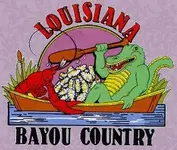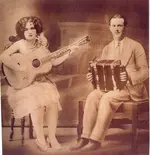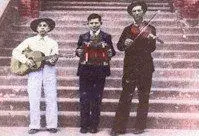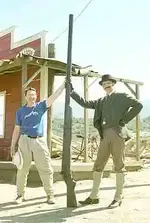Re: LOUISIANA BAYOU HUNT - DATE SET - APRIL '08 !
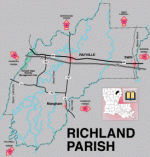
History of Richland Parish
1729 -
Richland Parish was originally part of the Ouachita country which roughly defined the area between the Red and Mississippi rivers north to the Missouri River. The name Ouachita, pronounced ³Wash-i-taw², is derived from a tribe of Native Americans which inhabited that area when it was first explored by theFrench. European settlement of the area began about the same time as the founding of New Orleansbut the massacre of settlers at Natchez in 1729 induced the Ouachita settlers to move closer to the protection of more established communities down river.
1785 -
Don Juan Filhoil, a Frenchman in the Spanish military, was given command of the Ouachita and told to establish settlements in the area, which had become Spanish territory in 1769. He reported that no sign of the previous settlements existed and set out to build Fort Miro at the present site of the city of Monroe. About the same time the Spanish governor struck a deal with the Baron de Bastrop. If he would help populate the area he would be given a grant of over a million square acres of land. The Baron hired a man from Kentucky named Abraham Morehouse to encourage immigration to the Ouachita country. Settlers were promised title to 400 acres of land if they remained for three years. Although part of Richland was included in this grant, settlement of the parish was slower due to the unusually thick vegetation.
1805 -
When the Territory of Orleans is divided into counties the present-day Richland Parish is part of Ouachita County.
1836 -
The Ray family had moved into Ouachita Parish from Missouri about 1836. James & brother John was convinced shortly after by David Crockett and James Bowie that he should join the volunteers in an expedition to free Texas from Mexico.
He got as far as Natchitoches when he learned that he had missed death and immortality at the Alamo. John Ray returned to Monroe, established a law practice and was instrumental in establishing the first road and railroad that traversed Richland Parish.
During the Civil War Ray served in the Confederate Army, but maintained that the state should not have seceded. After the war he became involved in Republican politics, became a state senator, and introduced a bill to form the new parish. Although it passed easily, Democrats opposed the creation of new parishes during this period because it was used to spread the influence of the "carpetbagger" government.
1840 -
Settlement mostly occurred on small prairies near navigable streams. The prairies allowed the pioneers, mostly from the southeastern United States, to plant crops without clearing the land of trees. About 1840 a road was built through the vast canebrake and swamp area between the Boeuf River and Bayou Maçon. This road had to be continuously cleared because of the encroaching vegetation. Most of the transportation in the area was by steamboat which supplied settlements to the north along the Boeuf River and Bayou Maçon.
1844 -
Due to the population increase, Morehouse Parish is created from the parent parish of Ouachita by an act of the Louisiana Legislature in 1844 and at the time included within its boundary part of what is now Richland Parish.
1854 -
In 1854 railroad construction began to reach into northern Louisiana and by 1861 the first line to Monroe had crossed Richland Parish. Settlement and development of the parish was halted however by the Civil War. Commerce in the area disappeared and thousands of acres of land that had been cleared for cotton production were abandoned and reverted to forest growth.
1868 -
Richland Parish is established by an act of the Louisiana Legislature on September 29, 1868, during the early part of the "reconstruction era". It is carved out of parts of Carroll, Franklin, Morehouse and Ouachita parishes.
It was named Richland because of the fertility of its soil. Rayville was immediately chosen as the seat of the parish government, although at that time it was a very small settlement. The town having been named for James Ray, who ran a store on the site.
Democrats opposed the formation of new parishes during the Reconstruction Era because it spread the influence of the Republican "carpetbagger" government.
1880 -
A new era of economic activity began during 1880s with the revival of cotton production. The better drained lands that were accessible to the new railroads were cleared and cultivated for cotton. Since shipment no longer depended upon water transportation, some cotton land near the bayous was abandoned in favor of that near the railroads. In 1890 another line was built through Rayville to Natchez, providing a north-south railroad system.
1900 -
Lumber production became an important industry between 1900 and 1910, and reached its peak between 1915 and 1920 when the post World War I agricultural boom encouraged the planting of cut-over timberlands in cotton. Cotton acreage continued to expand until the great Depression of the 1930s. Richland has always been agricultural, with Cotton the King in acreage and market value. The parish still ranks second in the state in cotton production. Other products of increasing importance are livestock and dairy products. During the 1950s the Louisiana Department of Public Works constructed an extensive system of drainage in the parish, which has resulted in availability of additional land suitable for farming.
Communities of Richland Parish
There are 3 incorporated communities in Richland Parish -
Delhi
Mangham
Rayville
Unincorporated areas of interest in the parish -
Alto, Archibald, Bardel, Bee Bayou, Buckner,
Charlieville,Crew Lake, Dun, Girard, Goff,
Holly Ridge, Jonesburg, New Light,
Producers Spur, Rhymes, Start,
Sun Spur and Warden








